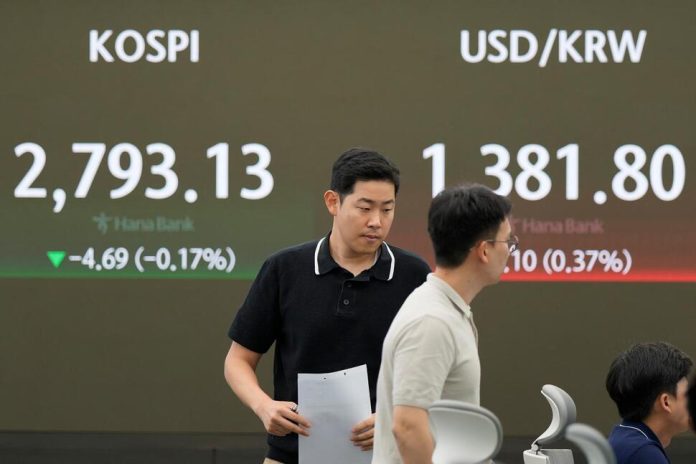Asian markets showed mixed performance on Monday, influenced by divergent economic reports from Japan and China, while global markets awaited further cues from economic data and geopolitical developments.
Japan’s benchmark Nikkei 225 index rose by 0.3% to reach 39,693.29, buoyed by the Bank of Japan’s quarterly “tankan” survey, which indicated a slight improvement in confidence among the country’s largest manufacturers during the April-June quarter. However, Japan’s government revised its first-quarter growth estimate downward to a -2.9% annual rate, reflecting ongoing economic challenges.
In China, the Shanghai Composite Index climbed 0.3% to 2,976.64. A survey of factory purchasing managers released over the weekend highlighted continued contraction in manufacturing activity for the second consecutive month. However, a separate private-sector survey published on Monday showed a positive uptick in business conditions, with the Caixin Manufacturing PMI rising to 51.8 in June, indicating expansion.
Hong Kong markets remained closed for a public holiday, limiting trading activity in the region.
Australia, the S&P/ASX 200 index declined by 0.3% to 7,744.20, influenced by broader market sentiments and economic indicators from major trading partners.
South Korea’s Kospi index edged up by 0.2% to 2,802.87 following a private-sector survey that revealed the country’s factory activity reached its highest level since April 2022. This positive data contributed to slight gains in the South Korean market.
The broader market sentiment in Asia was cautious, reflecting mixed economic signals and ongoing geopolitical uncertainties. Investors awaited further developments in global economic policies and indicators to gauge market direction.
Markets ended the previous week on a mixed note. The S&P 500 index closed 0.4% lower at 5,460.48, while the Nasdaq composite declined by 0.7% to 17,732.60. The Dow Jones Industrial Average also edged lower by 0.1% to 39,118.86. Despite these declines, both the S&P 500 and Nasdaq remained near their all-time highs, reflecting resilience in the U.S. equity market.
The S&P 500 posted a gain of 3.5%, bringing its year-to-date increase to approximately 14.5%. Similarly, the Nasdaq gained around 6% for the month and was up by 18.1% for the year, underscoring the strong performance of technology stocks despite recent volatility.
The market saw a pullback in major technology stocks towards the end of the week, impacting overall market sentiment. Stocks such as Apple, Microsoft, and Meta Platforms recorded losses, contributing to the broader market decline.
Investors also monitored inflation data, which showed a modest easing. The latest personal consumption expenditures index indicated a 2.6% rise in consumer prices in May compared to a year earlier, down from 2.7% in April and significantly lower than the peak of 7.1% observed two years ago. This gradual decline in inflation supported expectations that the Federal Reserve may consider adjusting interest rates to manage inflationary pressures effectively.
Bond market, Treasury yields initially fluctuated before rising following the inflation data release. The yield on the 10-year Treasury note increased to 4.38%, influencing interest rates on mortgages and other consumer loans. Expectations regarding Federal Reserve actions were closely monitored, with the two-year Treasury yield also showing slight movement.
Energy markets experienced modest gains, with benchmark U.S. crude oil rising by 39 cents to $81.93 per barrel on the New York Mercantile Exchange. Brent crude, the international standard, also increased by 41 cents to $85.41 per barrel, reflecting ongoing dynamics in global energy demand and supply.
Market participants remained focused on upcoming economic reports and corporate earnings announcements, which could provide further insights into global economic recovery and market stability. Geopolitical developments and policy decisions by central banks, particularly the Federal Reserve, were expected to influence market trends in the coming weeks.
Asian markets displayed mixed performance amid economic data disparities, global markets continued to navigate uncertainties with a cautious outlook, balancing economic recovery prospects with ongoing challenges.























